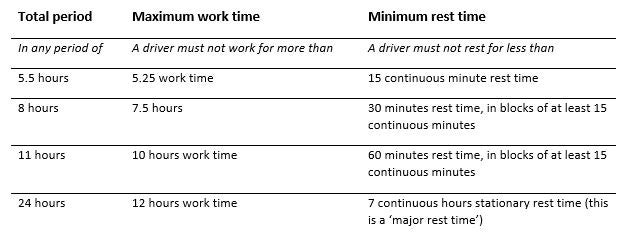18 February 2020
7 min read
#Transport, Shipping & Logistics
Published by:

Driver fatigue and drowsy driving is a major safety hazard for all vehicles using Australia’s roads. In fact driver fatigue is a leading contributor to heavy vehicle crashes in Australia, with some studies showing fatigue involved in one eighth of Australian heavy vehicle crashes.
More people in NSW died in fatigue-related crashes than drink driving crashes in the last five years. This is not surprising when you take into account that being awake for about 17 hours has a similar effect on performance as a blood alcohol content (BAC) of 0.05.
The Heavy Vehicle National Law (HVNL) attempts to address that hazard by imposing various obligations, including counting time and record keeping requirements, to ensure that the main causes of fatigue are addressed.
Fatigue-regulated heavy vehicles
National heavy vehicle driver fatigue laws apply to fatigue-regulated heavy vehicles, which are:
A primary duty exists at the heart of the laws for fatigue management – a driver must not drive a fatigue-regulated heavy vehicle on a road while impaired by fatigue.
What are the HVNL fatigue requirements?
The legislative regime is covered under part 6.2 of the HVNL.
Section 26C is the primary duty in the HVNL. Each party in the chain of responsibility for a heavy vehicle must ensure, so far as is reasonably practicable, the safety of the party’s transport activities relating to the vehicles.
Section 26E of the HVNL requires that a person must not ask, direct or require (directly or indirectly) the driver of a heavy vehicle or a party in the chain of responsibility to do or not do something the person knows, or ought reasonably to know, would have the effect of causing the driver:
How do you recognise fatigue?
The main purpose of fatigue management under the HVNL is to prevent drivers being impaired by fatigue when operating a vehicle and ensure that those in the supply chain aren’t influencing (or in some cases demanding) those drivers to drive while fatigued.
In considering whether your origination has breached its obligations in relation to fatigue management, a court will look to any cause or signs of fatigue arising in the circumstances of the relevant transport activities. Cause of fatigue means “any factor that could cause or contribute to a person being fatigued while driving a fatigue-regulated heavy vehicle on a road (whether or not the cause arises while the person is at work)”. Examples of signs of fatigue, as defined in section 221 of the HVNL, include:
Counting time
The HVNL and the Regulations require that work time and rest time be counted in a certain way. Understanding the rules for counting time helps drivers manage work and rest times and assist other responsible parties in the CoR comply with their duties to manage work and rest time and prevent driver fatigue.
Part 6.3 of the HVNL identifies drivers’ work and rest time requirements. Sections 250 and 251 require drivers (solo and two-up) to avoid:
The standard work and rest hours for a given period are set out in tables in Schedule 1 of the Heavy Vehicle (Fatigue Management) National Regulation (Regulations). For example, it provides for a solo driver of a fatigue-regulated heavy vehicle:

Work diary
Drivers of a fatigue-regulated vehicle undertaking or planning to undertake a journey of 100+km in a day must complete their work diary (including all work and rest) for that day.
What work and rest options are available?
The HVNL prescribes three work and rest hour options for drivers of fatigue-regulated heavy vehicles and induce the following:
Standard hours in the HVNL apply to drivers operating without BFM or AFM accreditation. The standard hours option specifies the maximum amount of work and minimum periods of rest allowable under the HVNL without requiring heavy-vehicle drivers and operators to adopt additional safety measures or obtain further accreditation.
BFM and AFM provide increased levels of flexibility by managing fatigue risks through the National Heavy Vehicle Accreditation Scheme (NHVAS). Heavy vehicle drivers can only work under these hours if they have been inducted into an accredited operators system.
Record keeping requirements for fatigue compliance
Under the HVNL you are required to take all reasonably practicable steps to ensure that your employees are suitably trained in CoR compliance. It is extremely important to document all your policies and procedures. This is not only to ensure that those policies and procedures are clear, easily disseminated and consistent, but also to assist your business in showing that all reasonably practicable steps have been taken should you be investigated or prosecuted.
It is a breach punishable by penalty and prosecution if you fail to keep those records. This includes keeping a record of specific information for drivers of fatigue regulated heavy vehicles. For each driver the record keeper must keep:
In some circumstances, some businesses may be exempt from certain record-keeping obligations. Particularly, where it may be extremely difficult to comply with or if it can result in multiple recordkeeping systems being kept for different legislative obligations. In these cases, operators can apply for a fatigue record-keeping exemption (permit) from the National Heavy Vehicle Regulator.
Risk management systems
Documenting policies and procedures becomes extremely important, not only for ensuring that those policies and procedures are clear, easily disseminated and consistent, but also to assist businesses in showing that “all reasonably practicable steps” have been taken should you be investigated or prosecuted.
Businesses should consider implementing a risk management system to address the risks associated with fatigue. Such as system will assist in satisfying the requirements of the HVNL as they relate to heavy vehicle driver fatigue and can allow your organisation to:
Author: Meshal Althobaiti
* A version of this article was originally published in CoR Adviser. This article is © 2020 Portner Press Pty Ltd and has been reproduced with permission of Portner Press.
Disclaimer
The information in this publication is of a general nature and is not intended to address the circumstances of any particular individual or entity. Although we endeavour to provide accurate and timely information, we do not guarantee that the information in this newsletter is accurate at the date it is received or that it will continue to be accurate in the future.
Published by: